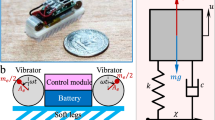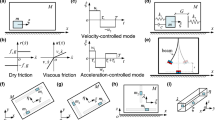Abstract
Microrobotics is a growing field with great advances in recent years. New applications in the fields of medicine, biology, manufacturing and maintenance technologies are developed. They require mobile systems with enhanced motion abilities. The present paper concerns principles of terrestrial locomotion for vibration-driven microrobots. Such systems are characterized by an internal periodic excitation, which is transformed to a directed motion due to asymmetric system properties. An extensive overview on the state of the art shows the great potential of the vibration-driven locomotion for miniaturized applications in technics. To perform a controllable two-dimensional locomotion with only one actuator, it is needed to overcome limits of rigid body systems. The proposed approach uses the frequency-dependent vibration behavior of elastic systems, like beams and plates. Experimental investigations are supported by finite element method. It is shown that the two-dimensional locomotion on a flat and solid ground can be controlled by only one actuator using the resonance characteristics of elastic systems.
Access this chapter
Tax calculation will be finalised at checkout
Purchases are for personal use only
Similar content being viewed by others
References
Abaza K (2007) Ein Beitrag zur Anwendung der Theorie undulatorischer Lokomotion auf mobile Roboter. Dissertation, TU Ilmenau
Abbott JJ, Nagy Z, Beyeler F, Nelson BJ (2007) Robotics in the small: P. 1. microbotics. IEEE Robot Autom Mag 14(2):92–103
Asano M, Matsuoka T, Okamoto H et al (1995) Study for micro mobile machine with piezoelectric driving force actuator. In: Proceedings of the IEEE international conference on robotics and automation (ICRA), vol 3, pp 2955–2960
Avirovik D, Butenhoff B, Priya S (2014) Millipede-inspired locomotion through novel U-shaped piezoelectric motors. IOP Smart Mater Struct 23:1–5
Baisch AT, Heimlich Ch, Karpelson M, Wood RJ (2011) HAMR3: an autonomous 1.7 g ambulatory robot. In: Proceedings of the IEEE/RSJ international conference on intelligent robots and systems (IROS), pp 5073–5076
Becker F (2015) Zur Mechanik vibrationsgetriebener Roboter für terrestrische und aquatische Lokomotion. Dissertation, TU Ilmenau
Becker F, Minchenya V, Zimmermann K et al (2012) Single piezo actuator driven micro robot for 2-dimensional locomotion. In: Micromechanics and microactuators, vol 2. Springer, Berlin, pp 1–10
Besocke K (1987) An easily operable scanning tunneling microscope. Surf Sci 181:145–153
Blekham II (2000) Vibrational mechanics: nonlinear dynamic effects, general approach, application. World Scientific, Singapore
Bogue R (2015) Miniature and microrobots: a review of recent developments. Ind Robot 42(2):98–102
Bolotnik N, Figurina T (2008). Vibration-driven systems with movable internal masses: control and optimization. Proceedings of the 53nd international scientific colloquium, Ilmenau, 8–12 Sept 2008, pp 31–32
Bolotnik N, Pivovarov M, Zeidis I et al (2016) The motion of a two-body limbless locomotor along a straight line in a resistive medium. Z Angew Math Mech 4:429–452
Caprari G (2003) Autonomous micro-robots: applications and limitations. Dissertation, École polytechnique fédérale de Lausanne
Daugela A, Fujii H, Jeronymo CE et al (1995) Piezo ceramic based locomotive drive. In: Proceedings of the 6th IEEE international symposium of micro machine and human science, pp 187–192
DeAmbroggi F, Fortuna L, Muscato G (1997) PLIF: piezo light intelligent flea-new micro-robots controlled by self-learning techniques. In: Proceedings of the IEEE international conference on robotics and automation (ICRA), vol 2, pp 1767–1772
Diller E, Sitti M (2013) Micro-scale mobile robotics. Found Trends Robot 2(3):143–259
Driesen W (2008) Concept, modeling and experimental characterization of the modulated friction inertial drive (MFID) locomotion principle: application to mobile microrobots. Dissertation, École polytechnique fédérale de Lausanne
Edqvist E, Snis N, Mohr R et al (2009) Evaluation of building technology for mass producible millimetre-sized robots using flexible printed circuit boards. J Micromech Microeng 19(7)
Eigoli AK, Vossoughi GR (2010) Dynamic modeling of stick-slip motion in a legged piezoelectric driven microrobot. Int J Adv Robotic Syst 7(3):201–208
Estaña R, Woern H (2007) The MiCRoN robot project. Informatik akutell, Autonome mobile systeme. Springer, Berlin, pp 334–340
Farahani AA, Suratgar AA, Talebi HA (2012) Optimal controller design of legless piezo capsubot movement. Int J Adv Robot Syst 10(126):1–7
Ferreira A, Fontaine J (2003) Dynamic modeling and control of a conveyance microrobotic system using active friction drive. IEEE-ASME T Mech 8(2):188–202
Ferreira A, Minotti P (1997) Control of a multidegree of freedom standing wave ultrasonic motor driven precise positioning system. Rev Sci Instrum 68(4):1779–1786
Gidoni P, Noselli G, DeSimone A (2014) Crawling on directional surfaces. Int J Non-Linear Mech 61:65–73
Hariri HH, Soh GS, Foong SH et al (2015) Miniature piezoelectric mobile robot driven by standing wave. Proceedings of the 14th world congress in mechanism and machine science, pp 1–6
Hoffman KL, Wood RJ (2011) Passive undulatory gaits enhance walking in a myriapod millirobot. In: Proceedings of the IEEE/RSJ international conference on intelligent robots and systems (IROS), pp 1479–1486
Janocha H (2013) Unkonventionelle Aktoren: Eine Einführung. Oldenbourg Verlag, München
Kim B, Park S, Jee CY et al (2005) An earthworm-like locomotive mechanism for capsule endoscopes. In: Proceedings of the 2005 IEEE/RSJ international conference on intelligent robots and systems, 2–6 Aug 2005, pp 2997–3002
Lee K, Kim Y, Park JK et al (2015) Clawed miniature inchworm robot driven by electromagnetic oscillatory actuator. J Bionic Eng 12(4):519–526
Lepora NF, Verschure P, Prescott TJ (2013) The state of the art in biomimetics. Bioinspir Biomm 8(1):013001
Li W, Li J, Hu, H et al (2011) Analysis and experiment of stick-slip motion principle in a legged microrobot. In: Proceeding of the 6th forum on strategic technology, vol 1, pp 328–332
Lobontiu N, Goldfarb M, Garcia EA (2001) A piezoelectric-driven inchworm locomotion device. Mech Mach Theory 36(4):425–443
Lysenko V, Minchenya W, Zimmermann K (2007) Minimization of the number of actuators in legged robots using biological objects. In: Proceedings of the 52nd international scientific colloquium, Ilmenau, 10–13 Sept 2007, pp 483–488
Naguyen AT, Martel S (2007) Locomotion of a miniature robot based on synchronized vibrating actuation mechanisms. In: Proceedings of the IEEE/ASME international conference on advanced intelligent mechatronics (AIM), pp 1–6
Ostrowski J, Burdick J, Lewis AD et al (1995) The mechanics of undulatory locomotion: the mixed kinematic and dynamic case. In: Proceedings of the IEEE international conference on robotics and automation (ICRA), vol 2, pp 1945–1951
Rembold U, Fatikow S (1997) Autonomous microrobots. J Intell Robot Syst 19(4):375–391
Rios SA, Fleming AJ, Yong YK (2015) Design of a two degree of freedom resonant miniature robotic leg. In: Proceedings of the IEEE international conference on advanced intelligent mechatronics (AIM), pp 318–323
Sahu B, Taylor CR, Leang KK (2010) Emerging challenges of microactuators for nanoscale positioning, assembly, and manipulation. J Manuf Sci Eng 132(3):030917-1–16
Sitti M, Ceylan H, Hu W et al (2015) Biomedical applications of untethered mobile milli/microrobots. Proc IEEE 103(2):205–224
Snis N (2008) Actuators for autonomous microrobots. Digital Comprehensive Summaries of Uppsala Dissertations from the Faculty of Science and Technology 431, Uppsala University
Son KJ, Kartik V, Wickert JA et al (2006) An ultrasonic standing-wave-actuated nano-positioning walking robot: piezoelectric-metal composite beam modeling. J Vib Control 12(12):1293–1309
Steigenberger J (2011) Some theory towards a stringent definition of ‘locomotion’. Multibody Syst Dyn 26(1):81–90
Steigenberger J, Behn C (2012) Worm-like locomotion systems: an intermediate theoretical approach. Oldenbourg Verlag, München
Uchino K (1998) Piezoelectric ultrasonic motors: overview. Smart Mater Struct 7:273–285
Woern H, Szymanski M, Seyfried J (2006) The I-SWARM project. In: Proceedings of the 15th IEEE international symposium on robot and human interactive communication, pp 492–496
Yan G, Lu, Q, Ding G et al (2002) The prototype of a piezoelectric medical microrobot. In: 13th IEEE international symposium of micromechtronics and human science, pp 73–77
Yuxin P, Yulong P, Gu X et al (2015) A review of long range piezoelectric motors using frequency leveraged method. Sensor Actuat A-Phys 235:240–255
Zhan X, Xu J, Fang H (2015) Planar locomotion of a vibration-driven system with two internal masses. Appl Math Model. http://dx.doi.org/10.1016/j.apm.2015.06.016
Zimmermann K, Zeidis I, Behn C (2009) Mechanics of terrestrial locomotion. Springer, Berlin
Acknowledgments
The research work reported here was partly supported by Deutsche Forschungsgemeinschaft Grant ZI 540/19-1.
Author information
Authors and Affiliations
Corresponding author
Editor information
Editors and Affiliations
Rights and permissions
Copyright information
© 2017 Springer International Publishing Switzerland
About this paper
Cite this paper
Becker, F., Lysenko, V., Minchenya, V.T., Kunze, O., Zimmermann, K. (2017). Locomotion Principles for Microrobots Based on Vibrations. In: Zentner, L., Corves, B., Jensen, B., Lovasz, EC. (eds) Microactuators and Micromechanisms. Mechanisms and Machine Science, vol 45. Springer, Cham. https://doi.org/10.1007/978-3-319-45387-3_9
Download citation
DOI: https://doi.org/10.1007/978-3-319-45387-3_9
Published:
Publisher Name: Springer, Cham
Print ISBN: 978-3-319-45386-6
Online ISBN: 978-3-319-45387-3
eBook Packages: EngineeringEngineering (R0)




